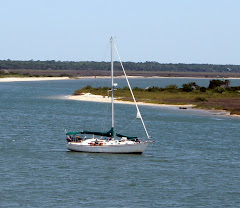
PART I
While in Hopetown earlier this week, we visited the Wyannie Malone Historical Museum. The museum was established by the community of Loyalists who settled in Hopetown shortly after the Revolutionary War. The kids learned a lot about the history of the Abacos, as well as various ways early island residents attempted to make their living. Here are their reports.
Elbow Cay Light House, by Jake
Hi, it’s Jake. Now here is my story. The light house is 89 feet tall with 98 steps. The light can shine 17 miles and flashes 5 times every 15 seconds. It was built in 1863.
OH! I forgot Franklin! He’s been the light house keeper working there for 40 years. OH! I forgot this too. The light runs on kerosene and there’s only three in the Bahmas that do this. He has to crank a weight up to the top to keep it going but he has to do this every 2 hours even in a hurricane - no, no, and no break! That’s it from Jake on Jubilee.
Turtling, by Drew
When the British Loyalists landed in Hope Town in 1765 they looked for ways to make money. Also they needed food. One thing they discovered was turtling.
They did it by making an iron ring with neting in the middle. They would look for a turtle to surface, then would throw the ring on them. The turtle would try to get out but would tangle it self instead. When it got tangled it would be towed slowing in to the harbor. Then still alive it would be killed and butchered and sold immediately. Otherwise the meat would go bad in the midday sun, because of lack of refrigeration. If they caught a girl turtle that had eggs it would be highly prized.
Though they don’t do it as much today, it is still a tradition in some islands to catch turtles.
Sponging Experts, by Emily
Sponging was a sport and a big business too back then in the 1700s. They would take a big boat out with 4 dinghies. They’d go to a plase called they called “the mud”. The men anchored the big boat, put the dinghies in the water, got in them and patl’d away.
They would put a glass bottom buckit in the water and paint it black insighed so there would be no glair. They’d find the sponges and pick them up with 3-prond focks. Then they let them drie for 3 days. They’d do this for 3 months then come back to port to sell their sponges.
PART 2
Next our field team is going to tell you what they know about biomes. This was the topic of a recent science lesson at Jubilee Elementary.
Deciduous Forest, by Emily
Red, Yellow, Orange... I am walking deaper in to the Deciduous Forest. Then I stop to smell the good air. Suddenly I notice the air doesn’t smell that good then I see a mommy skunk with its three babies. Then I see a hawk flying in the blue sky. I see a cardinel peking at a dead leaf. You see a lot of animals in the Deciduous forest like hawks, cardinels, crows, gardner snakes, bees, deer, raccoons and skunks.
Deciduous means decay = good soil. Leafs fall then there dead and the soil sucks it up and it makes good, good soil.
Deciduous forests are in the eastern USA. Some of these pretty, pretty forests are geting cut down for towns and cities, but some are National Parks. The End.
Taiga, by Drew
The taiga is a type of biome located in Europe, Asia and North America. It is a neighbor to another biome named the tundra, so it is very cold. Many birds live in the taiga in the summer, but they move to warmer places in the fall.
If you walk around up there, you might hear a chain saw or two because the taiga is one of the sources for our growing world’s timber.
Grassland, by Jake
I’m a lion. I live on grassland. There are a bunch of animals like gazelles, cheataz leaping through the air, zeabras, elephants, tigers, giraffes, water bufalos abd they’re all in my neighborhood in the savana.
It’s amazing that me and all these animals are in a small place living so close together, but the land that I know as grassland is also farming land and it keeps geting smaller because farmers are taking it to graze their cattle.





No comments:
Post a Comment